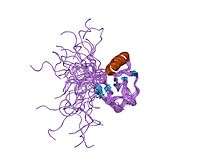PAN domain
PAN domains have significant functional versatility fulfilling diverse biological roles by mediating protein-protein and protein-carbohydrate interactions.[1] These domains contain a hair-pin loop like structure, similar to that found in knottins but with a different pattern of disulfide bonds.
| PAN_1 | |||||||||
|---|---|---|---|---|---|---|---|---|---|
 solution structure of a pan module from eimeria tenella | |||||||||
| Identifiers | |||||||||
| Symbol | PAN_1 | ||||||||
| Pfam | PF00024 | ||||||||
| Pfam clan | CL0168 | ||||||||
| InterPro | IPR003014 | ||||||||
| PROSITE | PDOC00376 | ||||||||
| SCOPe | 1bht / SUPFAM | ||||||||
| |||||||||
It has been shown that the N-terminal domains of members of the plasminogen/hepatocyte growth factor family, the apple domains of the plasma prekallikrein/coagulation factor XI family, and domains of various nematode proteins belong to the same module superfamily, the PAN module.[1] The PAN domain contains a conserved core of three disulfide bridges. In some members of the family there is an additional fourth disulfide bridge that links the N- and C-termini of the domain.
The apple domain, as well as other examples of the PAN domain, consists of 7 β-strands that fold into a curved antiparallel sheet cradling an α-helix. Two disulfide bonds lock the helix onto the central β4 and β5 strands, whereas a third connects the N- and C-termini of the domain. In the apple domain, the β4-β5 loop and β5-β6 crossover loop generate a small pocket on the opposite side of the sheet from the α-helix.[2]
In native plasminogen the PAN domain is associated with five kringle domains.[3] The interactions between the PAN domain and the kringles play a critical role in stabilising the quaternary complex of the native plasminogen;
References
- Tordai H, Bányai L, Patthy L (November 1999). "The PAN module: the N-terminal domains of plasminogen and hepatocyte growth factor are homologous with the apple domains of the prekallikrein family and with a novel domain found in numerous nematode proteins". FEBS Lett. 461 (1–2): 63–7. doi:10.1016/s0014-5793(99)01416-7. PMID 10561497.
- Emsley J, McEwan PA, Gailani D (Apr 2010). "Structure and function of factor XI". Blood. 115 (13): 2569–77. doi:10.1182/blood-2009-09-199182. PMC 4828079. PMID 20110423.
- Xue Y, Bodin C, Olsson K (2012). "Crystal structure of the native plasminogen reveals an activation-resistant compact conformation". J Thromb Haemost. 10 (7): 1385–96. doi:10.1111/j.1538-7836.2012.04765.x. PMID 22540246.